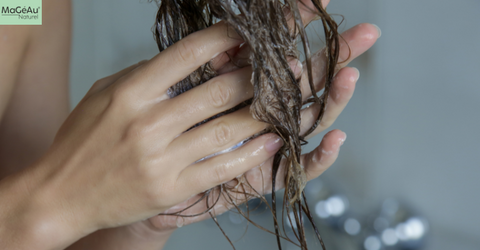Why does the Order Matter?
The order of shampoo and conditioner can impact the health and appearance of your hair. It might seem like a minor detail, but depending on your hair type, scalp condition, and personal needs, the sequence can make a big difference. Let's start with the basics.What Does Shampoo Do?
Shampoo cleanses the hair and scalp by removing dirt, oil, and product buildup. While cleansing is essential, many shampoos can strip natural oils, leading to dryness and frizz. This is especially true for people struggling with:- Hair loss
- Dandruff
- Dry or brittle hair
What Does a Conditioner Do?
Conditioner is designed to hydrate, detangle, and protect your hair. It smooths the hair cuticle, reducing frizz and adding shine. But here's something less commonly known: modern conditioners are more than just moisturisers. Many formulas today:- Stimulate regrowth by nourishing hair follicles.
- Reduce hair loss by strengthening weak strands.
- Provide anti-dandruff benefits by soothing irritated scalps.
The "Conditioner-First" Method: Who Benefits?
Applying conditioner before shampoo, known as reverse washing, has become popular for a good reason. This method is particularly helpful for people with:- Thin or fine hair: Conditioners can sometimes weigh down fine hair, making it look flat or greasy. Applying it first ensures your hair still gets hydration without losing volume.
- Oily scalps: If you struggle with an oily scalp but dry ends, conditioning first can help nourish the lengths of your hair while preventing extra buildup on the scalp.
- Dandruff-prone hair: Applying conditioner before shampoo allows the anti-dandruff shampoo to directly target the scalp without being blocked by leftover conditioner residue.
The Traditional "Shampoo-First" Method: Best for Most People
For most hair types, applying shampoo first is the standard way to cleanse and prepare your hair for conditioning. This method is particularly suitable if:- You have normal to thick hair that benefits from extra hydration.
- Your scalp tends to get dry, as conditioner seals in moisture after cleansing.
- You use a shampoo designed to reduce hair loss, stimulate regrowth, or fight dandruff.
How to Decide?
Here are some tips to help you choose the best method:Understand Your Hair Type:
- Fine hair? Try reverse washing to avoid flatness.
- Thick, curly, or dry hair? Stick with the traditional method for maximum hydration.
Focus on Your Scalp Condition:
- If dandruff is your main concern, shampoo should always come first to ensure the active ingredients work effectively.
Experiment:
- Try both methods for a week each and see how your hair feels.
Extra Tips for Better Results
No matter the method, these tips can make your routine more effective:- Choose the Right Products: Look for shampoo and conditioner that match your needs, such as anti-dandruff properties, hydration, or formulas to reduce hair loss.
- Don’t Overdo It: Too much shampoo can dry out your hair, while over-conditioning can lead to greasiness. Stick to a dime-sized amount of product unless you have very long hair.
- Rinse Thoroughly: Make sure to rinse out all the product to avoid buildup and irritation.
- Use Lukewarm Water: Hot water can strip your scalp of natural oils, while cold water can help seal the hair cuticle for extra shine.
The Bottom Line
There’s no universal answer to whether you should apply conditioner before or after shampoo. It all comes down to your hair type and personal needs. If you're looking for volume or have an oily scalp, try reverse washing. If you need hydration, shine, or anti-dandruff benefits, stick with the traditional method. Whatever you choose, using high-quality products tailored to your concerns – like reducing hair loss, stimulating regrowth, or tackling dandruff – will make all the difference.Experiment and listen to your hair. Over time, you'll find the perfect routine for you!





Comments (0)
There are no comments for this article. Be the first one to leave a message!